
By Angelo Randaci, Earth’s Ally Horticulturist
Angelo’s passion for plants has led him to explore many areas of horticulture including research, grounds management, technical training, design and nursery management.
Expansive lawns were fashionable in the suburbs years ago. Perfectly manicured lawns groomed with amazing precision, and hedgerows pruned to perfection surrounded the city perimeter in the suburbs. Those meandering lawns were often adorned by annual and perennial flower beds. Hidden at the back of the property, tucked away behind the garage is where you could find the vegetable and herb gardens. The gardening techniques of the day focused mostly on chemical usage that ended up doing more harm than good. Racheal Carson, in her book Silent Spring, was one of the first conservationists to point out the destructive spiral we created with all the layers of chemical care poisoning our environment. Times have changed and much of the chemical usage has been curbed or even banned. All these years later you can have your green lawn without negative environmental impact.
Turfgrass management has gone through encouraging changes over the years. We now have a rising number of environmentally conscious companies using products that will positively impact the environment. Growing your lawn organically focuses on the overall health of your outdoor environment without causing harm to people, pets, and wildlife. Individual changes may sound insignificant against the backdrop of the climate crisis we face today but any change each of us makes to change the environment positively is one tiny but important step forward. If everyone changes their chemical gardening habits, we will see a change in the environmental impact.
An effective organic lawn protocol will use cultural control methods to avoid stress before it begins to create an environment for disease or insect problems. Just as preventative medicine is vital for our health, prevention and care are the keys to growing strong, healthy lawns using organic fertilizers and amendments that function as soil conditioners. These products contain microorganisms beneficial to the soil structure while also adding organic matter to the soil.
What Are Cultural Control Practices in Gardening?
Cultural controls are methods used to modify the lawn environment to reduce the need for chemicals and avoid plant stress. Since plants under stress are more prone to disease outbreaks, good cultural practices are key to reducing disease.
Test your soil for pH and nutrient levels. A soil test provides an estimate of your plant-available nutrients and will tell you whether you need to adjust the pH.
A buildup of thatch and compacted soils are common problems in existing lawns. Thatch is a combination of dead and living plant matter that accumulates at the base of your grass where the stems meet the soil. This can occur as a result of organic matter building up more quickly than the older organic matter can break down. Dethatching and aerating are useful steps for preparing the soil to accept soil amendments. A dethatching machine or dethatching rake removes this layer allowing water and soil amendments to penetrate to plant roots. A thatch layer of ½ inch is acceptable but if the thatch layer becomes too thick (1 inch or more) it can prevent air, water, and nutrients from reaching roots. It may also promote lawn diseases and insect infestations.
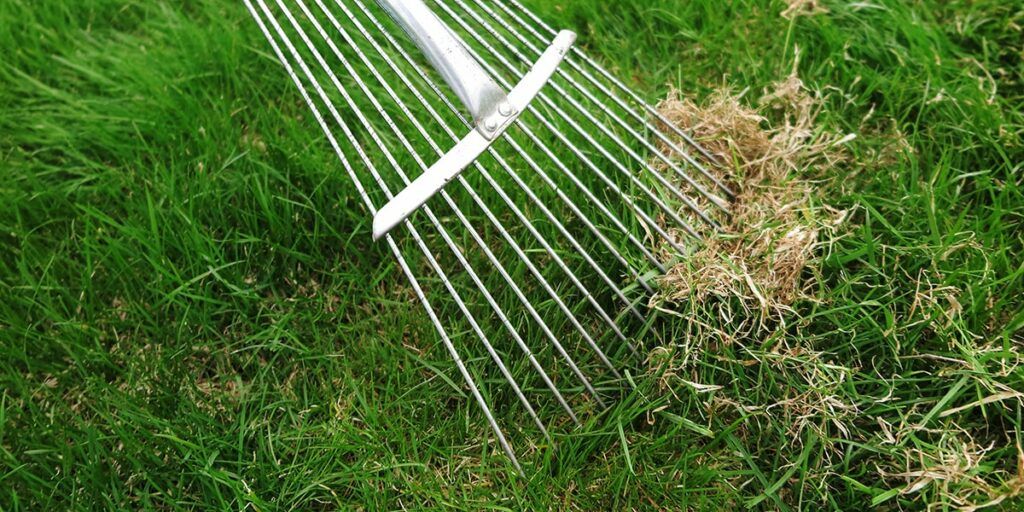
While dethatching removes the top-most layer of dead grass, aerating involves perforating the soil with small holes or removing plugs to aerate the soil.

This will also help water and fertilizer to penetrate the root layer. Aerating is especially beneficial to alleviate soil compaction in areas that receive heavy foot traffic. Follow recommendations from experts in your area on organic lawn care. They can help you work out a plan for either revitalizing or renovating your lawn.

Top-dress your lawn by spreading and raking in a thin layer of soil or compost 1/8 to 1/2 inches over your lawn. This will help improve drainage, reduce thatch, and add nutrients to the soil. Top dress after dethatching or aerating for greater penetration.
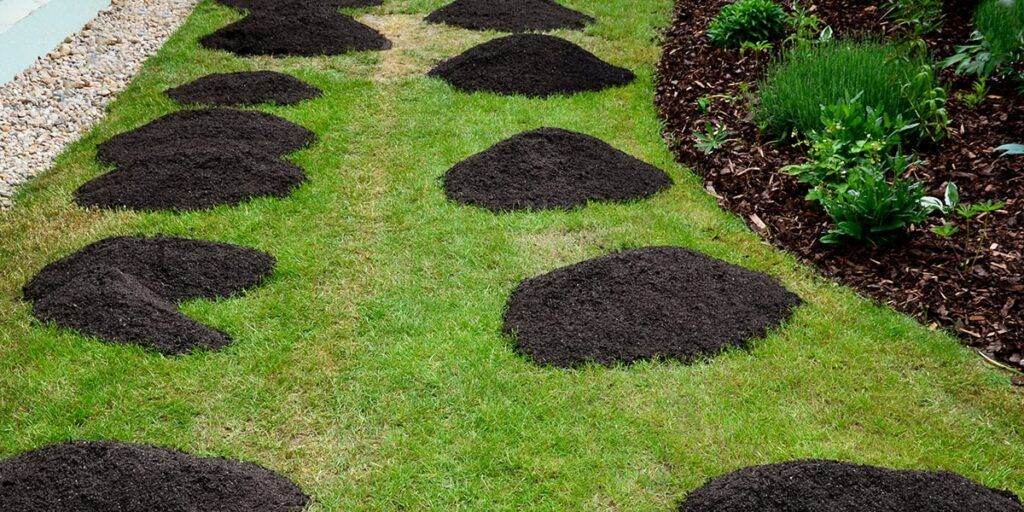
Using a mulching mower to return grass clippings to the lawn is valuable as well. The clippings decompose quickly adding nitrogen, phosphorus, potassium, and micronutrients back into the soil. Keep mower blades sharp. Dull blades leave a jagged edge on grass tips which invites pests and disease. A fresh cut will help the grass to heal faster reducing stress. Do not remove more than one-third of the grass height at a time.
How to Identify and Control Lawn Disease
The first step to solving a disease is to identify what is causing the problem. Fungal diseases occur during times of stress. The type and amount of fungal damage will vary depending on where you live. Warm-season grasses are stressed during abnormally cool temperatures, whereas cool-season grasses are most stressed during warmer than normal conditions. The following list of diseases, symptoms, signs, and controls will help you identify your turf disease. Search online for pictures to help you identify the problem. Take pictures of your turf to your local extension office for help.
All lawn diseases mentioned here can be treated using Earth’s Ally Disease Control for Lawns. It’s a new generation of disease control formulated from food-grade citric acid. The formula leaves no harmful residue on turf. Earth’s Ally can be safely applied year-round and has been independently tested and proven safe for bees. The bottle connects directly to garden hoses and the concentrated formula automatically mixes with water and treats up to 5,000 sq. ft.
Brown Patch (Rhizoctonia spp.)
Brown patch can infect all species of warm- and cool-season turfgrasses. The list includes tall fescue, St. Augustine grass, bentgrasses, centipedegrass, bermudagrass, and ryegrass. The problem occurs mostly during high daytime humidity and nighttime temperatures around 65 degrees. Favorable conditions for disease development can occur from late April through October. Prolonged wet soil and leaves along with high levels of nitrogen help spread the disease.
Symptoms and Signs: Look for blighted leaf blades appearing in circular brown or straw-colored patches. Webbing may be visible during early morning hours.
Rust (Puccinia spp.)
Zoysia, perennial ryegrass, and Kentucky bluegrass are primarily affected by this disease. The problem mostly occurs during late summer and early fall but can occur during the spring months as well. Shady areas with stagnant air movement are prime areas for this disease to thrive.
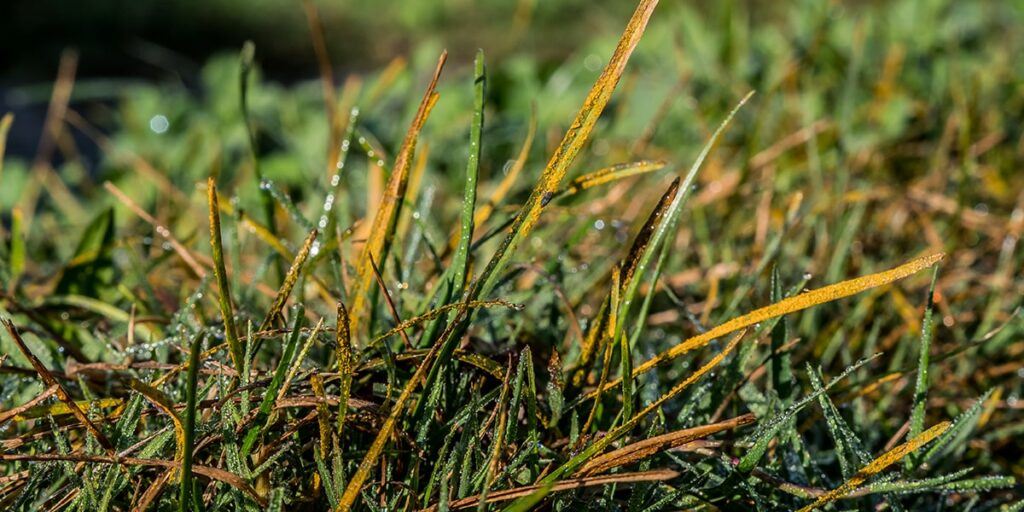
Symptoms and signs: From a distance, this disease appears as irregular light-green or yellow patches, but if you look closely, you will see orange-yellow spores on the grass blades.
Dollar Spot (Sclerotinia homoeocarpa)
Dollar spot can attack all species of both warm- and cool-season turfgrasses. Dry soil conditions along with low nitrogen levels promote dollar spot.
Symptoms and Signs: Symptoms include small circular straw-colored sections and may resemble Brown patch. Leaf-blades may display straw-colored lesions along one edge of the blade. White fungus may be evident during early morning hours.
Anthracnose (Colletotrichum cereale)
Anthracnose is a disease that can affect all turf species but is most often found on bentgrass and Kentucky bluegrass. The disease often develops because of stress during the heat of summer. It is often found on golf courses where the turf is intensely managed.
Symptoms and Signs: Grass blades turn a tan-yellowish color in irregular patches. Basal rot from anthracnose is normally seen in late autumn to early spring.
Summer Patch (Magnaporthiopsis poae)
Summer patch is a root and crown disease of annual bluegrass, Kentucky bluegrass, and fine fescues. The main causes are summer heat stress and/or drought conditions. Creeping bentgrass, perennial ryegrass, and tall fescues are highly resistant.
Symptoms and Signs: Small 2–4-inch diameter patches are often noticed first but as the disease progresses, the patches become progressively larger and may be anywhere from two inches to three feet in diameter. Patches can appear in different shapes and sizes together in an area in the form of rings, crescents, or spots. The fungus colonizes on the surface of the roots during spring through fall but signs of disease do not become visible until the turf is subjected to summer heat stress conditions. arly spring.
Powdery Mildew (Blumeria graminis)
Powdery mildew is almost always found in shaded turf areas. Kentucky bluegrass is most susceptible to this disease. It generally appears in late summer and fall and is rarely fatal.
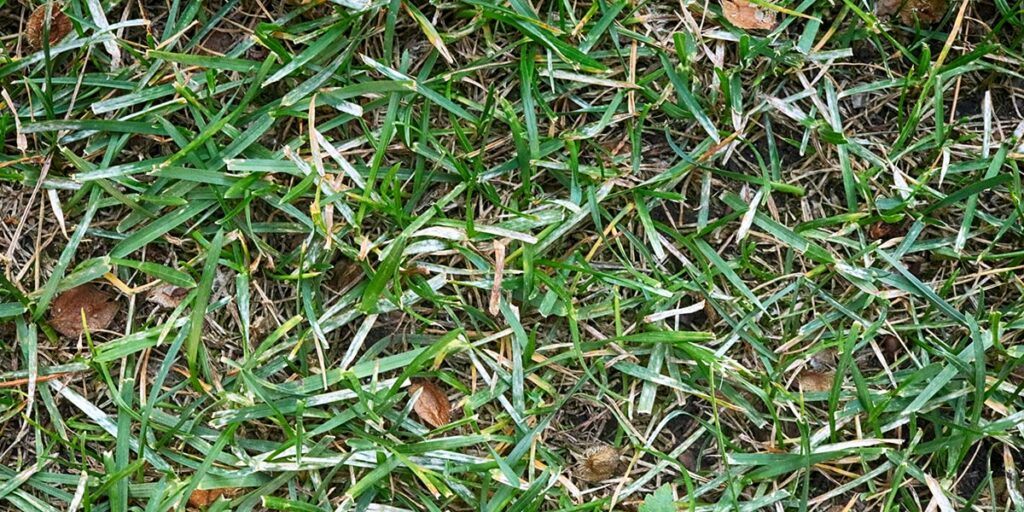
Symptoms and Signs: Gray to white spore masses appear on the upper surface of the leaves. The turf area infected will eventually develop a gray cast. Although leaves may turn yellow, the plants usually survive.
Abiotic Disorders
Abiotic disorders are those caused by non-living agents. These include environmental conditions such as the ones listed below.
Irrigation: Uneven irrigation from a broken sprinkler head will create a brown patch on the lawn. If your lawn is irrigated, check sprinkler heads often to make sure they are spaced so they don’t miss any areas and are in working order.
Animal Urine: Animal urine (especially dogs) will also cause brown patches in your lawn. This occurs most often during periods of high temperatures and drought conditions. Typical damage appears as a brown spot with a darker green outer ring. If you do not own a pet, observe areas of your lawn where others walk their dogs, especially along sidewalks.
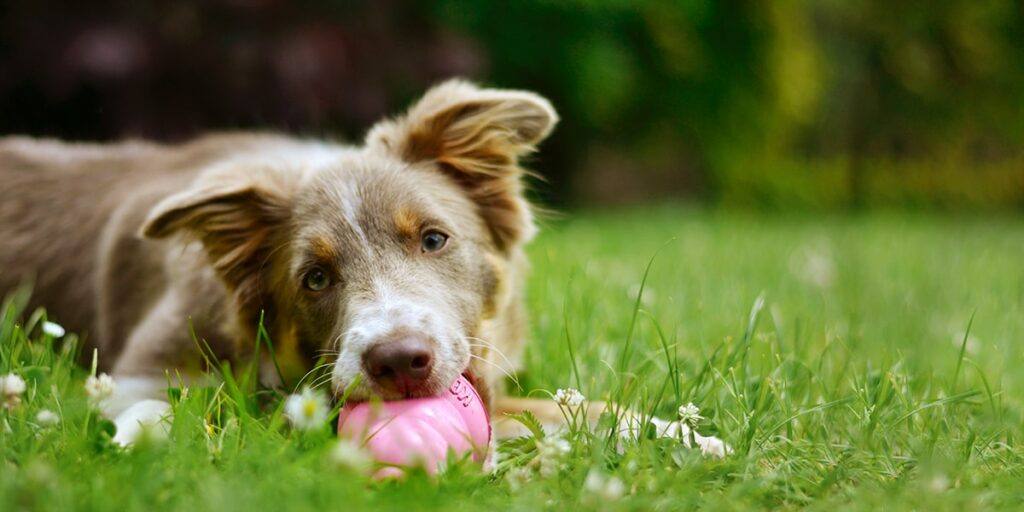
Fertilizer Damage: Uneven application of fertilizer may cause streaks of dark green grass next to missed areas which will remain light green. Be careful not to spill fertilizer on your lawn when filling your applicator as this will also cause brown patches from fertilizer burn.
Heat and Drought Stress: Turfgrass contains approximately 80 percent water. Lack of water along with high temperatures may cause your lawn to exhibit browning. Some species may go completely dormant. Most often your lawn will recover when it receives adequate moisture either from rain or irrigation. A sign of overly dry turf is when footprints or mower tire tracks do not recover quickly by bouncing back.
Shade: Most varieties of turf will be thin in shaded areas, especially near trees. Replace thin turf with shade-loving groundcovers with pathways to reduce foot traffic damage.
Chemicals, Gas, and Oil Damage: Turf can be damaged by household chemicals and petroleum products. Do not clean tools or other items with caustic chemicals such as paint thinners, bleach products, etc. on your turf. Do not fill mowers with gas or oil where they can spill on your lawn. Check mowing equipment for oil and gas leaks.
Ice Damage: I have seen damage from people dumping ice buckets on the turf after entertaining events during the summer months. The damage often appears in the shape of the container used to hold the ice.
Organic Lawn Pest Control
If you have pests in your turf, first you’ll want to identify the pest. You’ll want to make sure that the problem is caused by insects before taking any action. Brown spots and dead areas have many causes such as over or under watering, diseases, incorrect application of fertilizer, chemical spills, and animal urine to name a few. Avoid chemical pesticides. Only a small number of insects are harmful to your lawn. Over 90 percent of insects in your lawn are beneficial and help control insect pests. Adding chemical pesticides may kill beneficial insects and worms that help keep your lawn healthy. Explore other options such as essential oil blends which will have repellant properties, or Bacillus species to control grubs and Azadirachtin for cutworms. One way to discover if you have an insect problem is by performing a drench test.
To perform a drench test:
⦁ Measure out an area of about one square yard
⦁ Mix 3-4 tablespoons of dishwashing liquid in two gallons of water and evenly apply to your measured area
⦁ In about 10 minutes or so you should see the pest rising to the surface
⦁ Collect the pest for identification
We’d love to hear how Earth’s Ally is helping you care for your lawn! Share your experience and stay connected with the #EarthsAlly community on Facebook, Instagram and Twitter for access to our latest blog posts, giveaways and exclusive promotions.
